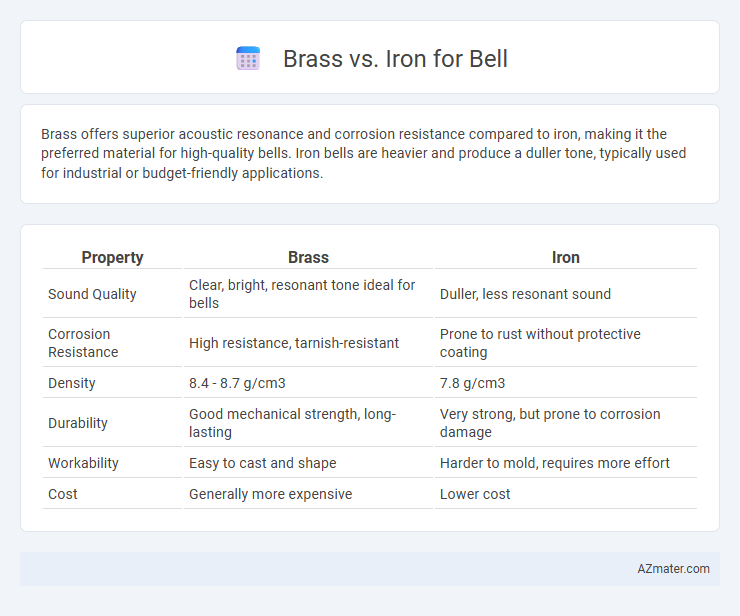Brass offers superior acoustic resonance and corrosion resistance compared to iron, making it the preferred material for high-quality bells. Iron bells are heavier and produce a duller tone, typically used for industrial or budget-friendly applications.
Table of Comparison
| Property | Brass | Iron |
|---|---|---|
| Sound Quality | Clear, bright, resonant tone ideal for bells | Duller, less resonant sound |
| Corrosion Resistance | High resistance, tarnish-resistant | Prone to rust without protective coating |
| Density | 8.4 - 8.7 g/cm3 | 7.8 g/cm3 |
| Durability | Good mechanical strength, long-lasting | Very strong, but prone to corrosion damage |
| Workability | Easy to cast and shape | Harder to mold, requires more effort |
| Cost | Generally more expensive | Lower cost |
Introduction to Bell Materials: Brass vs Iron
Brass and iron are two commonly used materials in bell manufacturing, each offering unique acoustic properties. Brass, an alloy of copper and zinc, produces a bright, resonant tone favored in musical and ceremonial bells, while iron provides a deeper, more subdued sound often used in industrial and large-scale bells. The choice between brass and iron impacts durability, corrosion resistance, and tonal quality, influencing the bell's application and longevity.
Historical Use of Brass and Iron in Bell Making
Brass has been favored historically in bell making for its superior acoustic properties, producing clear, resonant tones that have made it the material of choice since the medieval period. Iron bells, while less sonorous, have been utilized primarily for their durability and lower cost, often found in less prestigious or industrial settings during the 18th and 19th centuries. The transition from iron to brass in many cultures was driven by the increasing demand for musical quality in bells used in churches, schools, and public buildings.
Acoustic Properties: Sound Quality Comparison
Brass bells produce a bright, clear tone with rich harmonic overtones due to their high density and elasticity, enhancing resonance and sustain. Iron bells tend to emit a deeper, more muted sound with fewer overtones, resulting in a duller acoustic quality. The superior resonance and tonal complexity of brass make it the preferred choice for musical and ceremonial bells.
Durability and Longevity of Brass and Iron Bells
Brass bells exhibit superior durability due to their corrosion resistance and ability to withstand harsh weather conditions, ensuring long-lasting performance without significant rust or degradation. Iron bells, while strong, are more prone to rust and corrosion over time, especially in moist environments, which can compromise their structural integrity and sound quality. The longevity of brass bells typically surpasses that of iron bells, making them a preferred choice for outdoor and heritage installations demanding sustained durability.
Corrosion Resistance: Brass vs Iron Bells
Brass bells offer superior corrosion resistance compared to iron bells due to their copper and zinc alloy composition, which naturally resists oxidation and tarnishing in humid or marine environments. Iron bells are prone to rust and require protective coatings or regular maintenance to prevent corrosion, especially when exposed to moisture. This makes brass a more durable and low-maintenance choice for outdoor or coastal applications.
Cost and Availability of Materials
Brass bells generally cost more than iron bells due to the higher price of copper and zinc alloys compared to raw iron. Brass materials offer greater availability in specialized suppliers, while iron is widely accessible and often produced locally, reducing expenses. Cost-effectiveness favors iron for budget-conscious projects, but brass availability ensures durability and superior sound quality.
Visual Appeal: Aesthetic Differences
Brass bells showcase a warm, golden hue with a smooth, polished finish that enhances their elegant and traditional aesthetic appeal. Iron bells, in contrast, exhibit a darker, rustic look with a matte or weathered surface that conveys a rugged, antique charm. The choice between brass and iron directly influences the visual impact, with brass offering a bright and reflective appearance while iron provides a bold, industrial style.
Weight and Handling Considerations
Brass bells are generally heavier than iron bells due to the higher density of brass, which affects portability and ease of handling. Iron bells, while lighter, are more prone to corrosion and may require additional maintenance to preserve their structural integrity. The choice between brass and iron often depends on the balance between weight requirements and durability needs for specific bell applications.
Best Applications for Brass and Iron Bells
Brass bells excel in musical and decorative applications due to their bright, clear tone and resistance to corrosion, making them ideal for orchestras, doorbells, and ornamental use. Iron bells provide a more resonant, deep sound with greater durability and strength, suited for industrial settings, large church bells, and outdoor noise signaling. The choice depends on the desired sound quality, environmental exposure, and structural requirements.
Conclusion: Choosing the Right Material for Your Bell
Brass offers superior acoustic resonance and corrosion resistance, making it ideal for long-lasting, clear-toned bells used in decorative or ceremonial settings. Iron bells provide a harsher tone and are more prone to rust, but their durability and cost-effectiveness suit industrial or outdoor applications. Selecting the right material depends on balancing sound quality, environmental exposure, and budget constraints for your specific bell use.

Infographic: Brass vs Iron for Bell
 azmater.com
azmater.com